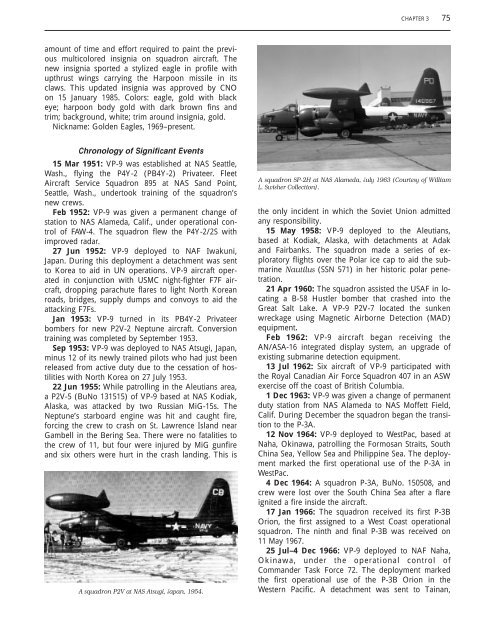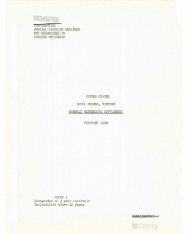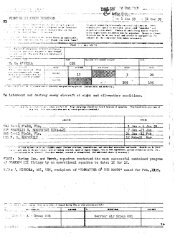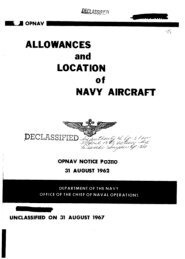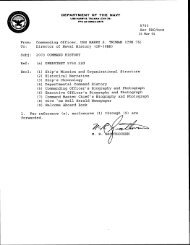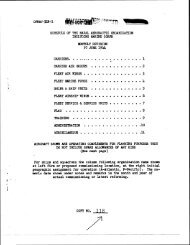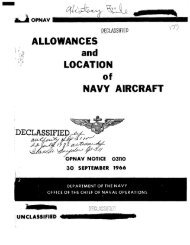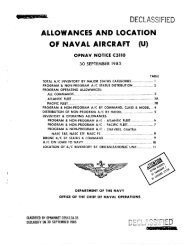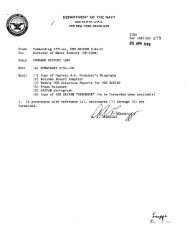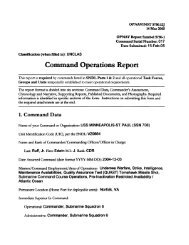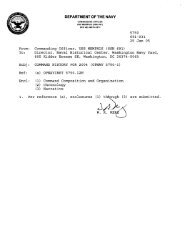VP-9 - Naval History and Heritage Command - U.S. Navy
VP-9 - Naval History and Heritage Command - U.S. Navy
VP-9 - Naval History and Heritage Command - U.S. Navy
Create successful ePaper yourself
Turn your PDF publications into a flip-book with our unique Google optimized e-Paper software.
CHAPTER 3 75<br />
amount of time <strong>and</strong> effort required to paint the previous<br />
multicolored insignia on squadron aircraft. The<br />
new insignia sported a stylized eagle in profile with<br />
upthrust wings carrying the Harpoon missile in its<br />
claws. This updated insignia was approved by CNO<br />
on 15 January 1985. Colors: eagle, gold with black<br />
eye; harpoon body gold with dark brown fins <strong>and</strong><br />
trim; background, white; trim around insignia, gold.<br />
Nickname: Golden Eagles, 1969–present.<br />
Chronology of Significant Events<br />
15 Mar 1951: <strong>VP</strong>-9 was established at NAS Seattle,<br />
Wash., flying the P4Y-2 (PB4Y-2) Privateer. Fleet<br />
Aircraft Service Squadron 895 at NAS S<strong>and</strong> Point,<br />
Seattle, Wash., undertook training of the squadron’s<br />
new crews.<br />
Feb 1952: <strong>VP</strong>-9 was given a permanent change of<br />
station to NAS Alameda, Calif., under operational control<br />
of FAW-4. The squadron flew the P4Y-2/2S with<br />
improved radar.<br />
27 Jun 1952: <strong>VP</strong>-9 deployed to NAF Iwakuni,<br />
Japan. During this deployment a detachment was sent<br />
to Korea to aid in UN operations. <strong>VP</strong>-9 aircraft operated<br />
in conjunction with USMC night-fighter F7F aircraft,<br />
dropping parachute flares to light North Korean<br />
roads, bridges, supply dumps <strong>and</strong> convoys to aid the<br />
attacking F7Fs.<br />
Jan 1953: <strong>VP</strong>-9 turned in its PB4Y-2 Privateer<br />
bombers for new P2V-2 Neptune aircraft. Conversion<br />
training was completed by September 1953.<br />
Sep 1953: <strong>VP</strong>-9 was deployed to NAS Atsugi, Japan,<br />
minus 12 of its newly trained pilots who had just been<br />
released from active duty due to the cessation of hostilities<br />
with North Korea on 27 July 1953.<br />
22 Jun 1955: While patrolling in the Aleutians area,<br />
a P2V-5 (BuNo 131515) of <strong>VP</strong>-9 based at NAS Kodiak,<br />
Alaska, was attacked by two Russian MiG-15s. The<br />
Neptune’s starboard engine was hit <strong>and</strong> caught fire,<br />
forcing the crew to crash on St. Lawrence Isl<strong>and</strong> near<br />
Gambell in the Bering Sea. There were no fatalities to<br />
the crew of 11, but four were injured by MiG gunfire<br />
<strong>and</strong> six others were hurt in the crash l<strong>and</strong>ing. This is<br />
A squadron P2V at NAS Atsugi, Japan, 1954.<br />
A squadron SP-2H at NAS Alameda, July 1963 (Courtesy of William<br />
L. Swisher Collection).<br />
the only incident in which the Soviet Union admitted<br />
any responsibility.<br />
15 May 1958: <strong>VP</strong>-9 deployed to the Aleutians,<br />
based at Kodiak, Alaska, with detachments at Adak<br />
<strong>and</strong> Fairbanks. The squadron made a series of exploratory<br />
flights over the Polar ice cap to aid the submarine<br />
Nautilus (SSN 571) in her historic polar penetration.<br />
21 Apr 1960: The squadron assisted the USAF in locating<br />
a B-58 Hustler bomber that crashed into the<br />
Great Salt Lake. A <strong>VP</strong>-9 P2V-7 located the sunken<br />
wreckage using Magnetic Airborne Detection (MAD)<br />
equipment.<br />
Feb 1962: <strong>VP</strong>-9 aircraft began receiving the<br />
AN/ASA-16 integrated display system, an upgrade of<br />
existing submarine detection equipment.<br />
13 Jul 1962: Six aircraft of <strong>VP</strong>-9 participated with<br />
the Royal Canadian Air Force Squadron 407 in an ASW<br />
exercise off the coast of British Columbia.<br />
1 Dec 1963: <strong>VP</strong>-9 was given a change of permanent<br />
duty station from NAS Alameda to NAS Moffett Field,<br />
Calif. During December the squadron began the transition<br />
to the P-3A.<br />
12 Nov 1964: <strong>VP</strong>-9 deployed to WestPac, based at<br />
Naha, Okinawa, patrolling the Formosan Straits, South<br />
China Sea, Yellow Sea <strong>and</strong> Philippine Sea. The deployment<br />
marked the first operational use of the P-3A in<br />
WestPac.<br />
4 Dec 1964: A squadron P-3A, BuNo. 150508, <strong>and</strong><br />
crew were lost over the South China Sea after a flare<br />
ignited a fire inside the aircraft.<br />
17 Jan 1966: The squadron received its first P-3B<br />
Orion, the first assigned to a West Coast operational<br />
squadron. The ninth <strong>and</strong> final P-3B was received on<br />
11 May 1967.<br />
25 Jul–4 Dec 1966: <strong>VP</strong>-9 deployed to NAF Naha,<br />
Okinawa, under the operational control of<br />
Comm<strong>and</strong>er Task Force 72. The deployment marked<br />
the first operational use of the P-3B Orion in the<br />
Western Pacific. A detachment was sent to Tainan,


